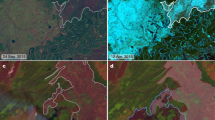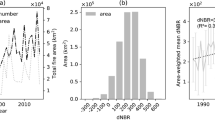Abstract
Climate warming is increasing the prevalence of overwintering ‘zombie’ fires, which are expected to occur primarily in peatlands, undermining carbon storage through deep burning of organic soils. We visited overwintering fires in Northwest Territories, Canada, and Interior Alaska, United States, and present field measurements of where overwintering fires are burning in the landscape and their impact on combustion severity and forest regeneration. Combustion severity hotspots did not generate overwintering, but peat and woody biomass smouldering both supported overwintering, leading to wintertime smouldering in both treed peatlands and upland forests. These findings create challenges for fire managers and uncertainty about carbon emissions, but forest regeneration was not compromised.
This is a preview of subscription content, access via your institution
Access options
Access Nature and 54 other Nature Portfolio journals
Get Nature+, our best-value online-access subscription
$32.99 / 30 days
cancel any time
Subscribe to this journal
Receive 12 digital issues and online access to articles
$119.00 per year
only $9.92 per issue
Buy this article
- Purchase on SpringerLink
- Instant access to full article PDF
Prices may be subject to local taxes which are calculated during checkout


Similar content being viewed by others
References
McCarty, J. L., Smith, T. E. L. & Turetsky, M. R. Arctic fires re-emerging. Nat. Geosci. 13, 658–660 (2020).
Walker, X. J. et al. Fuel availability not fire weather controls boreal wildfire severity and carbon emissions. Nat. Clim. Change 10, 1130–1136 (2020).
Scholten, R. C., Jandt, R., Miller, E. A., Rogers, B. M. & Veraverbeke, S. Overwintering fires in boreal forests. Nature 593, 399–404 (2021).
Xu, W., Scholten, R. C., Hessilt, T. D., Liu, Y. & Veraverbeke, S. Overwintering fires rising in eastern Siberia. Environ. Res. Lett. 17, 045005 (2022).
Irannezhad, M., Liu, J., Ahmadi, B. & Chen, D. The dangers of Arctic zombie wildfires. Science 369, 1171 (2020).
Witze, A. Why arctic fires are bad news for climate change. Nature 585, 336–337 (2020).
Johnstone, J. F. et al. Changing disturbance regimes, ecological memory, and forest resilience. Front. Ecol. Environ. 14, 369–378 (2016).
Turetsky, M. R. et al. Losing legacies, ecological release, and transient responses: key challenges for the future of northern ecosystem science. Ecosystems 20, 23–30 (2017).
Baltzer, J. L. et al. Increasing fire and the decline of fire adapted black spruce in the boreal forest. Proc. Natl Acad. Sci. USA 118, e2024872118 (2021).
Santoso, M. A. et al. in Fire Effects on Soil Properties (ed. Pereira, P.) 203–216 (CRC, 2019).
Parro, K. et al. Impact of postfire management on forest regeneration in a managed hemiboreal forest, Estonia. Can. J. For. Res. 45, 1192–1197 (2015).
Parker, K. L., Robbins, C. T. & Hanley, T. A. Energy expenditures for locomotion by mule deer and elk. J. Wildl. Manag. 48, 474 (1984).
Hayes, K. & Buma, B. Effects of short‐interval disturbances continue to accumulate, overwhelming variability in local resilience. Ecosphere 12, e03379 (2021).
Reid, K. A. et al. Black spruce (Picea mariana) seed availability and viability in boreal forests after large wildfires. Ann. For. Sci. 80, 4 (2023).
Johnstone, J. F. & Chapin, F. S. Effects of soil burn severity on post-fire tree recruitment in boreal forest. Ecosystems 9, 14–31 (2006).
Veraverbeke, S. et al. Lightning as a major driver of recent large fire years in North American boreal forests. Nat. Clim. Change 7, 529–534 (2017).
Walker, X. J. et al. Soil organic layer combustion in boreal black spruce and jack pine stands of the Northwest Territories, Canada. Int. J. Wildland Fire 27, 125 (2018).
Gallant, A. L., Binnian, E. F., Omernik, J. M. & Shasby, M. B. Ecoregions of Alaska (US Geological Survey, 1995).
Ecosystem Classification Group: Ecological Regions of the Northwest Territories—Taiga Plains (Department of Environment and Natural Resources, Govt of the Northwest Territories, 2009).
Walker, X. J. et al. Cross-scale controls on carbon emissions from boreal forest megafires. Glob. Change Biol. 24, 4251–4265 (2018).
Johnstone, J. F., Hollingsworth, T. N. & Chapin, F. S. A Key for Predicting Postfire Successional Trajectories in Black Spruce Stands of Interior Alaska (USDA, 2008).
Boby, L. A., Schuur, E. A. G., Mack, M. C., Verbyla, D. & Johnstone, J. F. Quantifying fire severity, carbon, and nitrogen emissions in Alaska’s boreal forest. Ecol. Appl. 20, 1633–1647 (2010).
Walker, X. J. et al. Increasing wildfires threaten historic carbon sink of boreal forest soils. Nature 572, 520–523 (2019).
R Core Team. R: A Language and Environment for Statistical Computing (R Foundation for Statistical Computing, 2020).
Bates, D., Mächler, M., Bolker, B. & Walker, S. Fitting linear mixed-effects models using lme4. J. Stat. Softw. 67, 1–48 (2015).
Lenth, R. V. emmeans: estimated marginal means, aka least-squares means. R package version 1.6.0, https://rvlenth.github.io/emmeans/ (2024).
Baltzer, J. L. et al. Data for: overwintering fires can occur in both peatlands and upland forests with varying ecological impacts. Borealis https://doi.org/10.5683/SP3/QYLJ1L (2025).
Walker, X. & Mack, M. C. Overwintering fires from 2009–2010 burns near Fairbanks, Alaska: post-fire seedling recruitment collected 2023 ver. 2. Environmental Data Initiative https://doi.org/10.6073/pasta/09228ba683a646d98cfbdddd564ce879 (2024).
Walker, X. & Mack, M. C. Overwintering fires from 2009–2010 burns near Fairbanks, Alaska: pre-fire tree species density and combustion collected 2023 ver. 2. Environmental Data Initiative https://doi.org/10.6073/pasta/f8abfc1f0a71f19b9a11d57ca6aa09ab (2024).
Walker, X. & Mack, M. C. Overwintering fires from 2009–2010 burns near Fairbanks, Alaska: residual soil organic layer depth, burn depth and thaw depth collected 2023 ver. 2. Environmental Data Initiative https://doi.org/10.6073/pasta/8e628fc7868b891774062ef5a3c166ba (2024).
Acknowledgements
The NT sampling campaign was supported by the Government of the Northwest Territories (GNWT) Environment and Climate Change funding to J.L.B. and in-kind helicopter support. Other logistical support was provided through the GNWT–Wilfrid Laurier University Partnership Agreement. J.L.B. was supported by the Canada Research Chairs Program and Natural Science and Engineering Research Council Discovery Grant funding (RGPIN-2019-05889). T.D.H. was supported under the umbrella of the Netherlands Earth System Science Centre, which received funding from the European Union Horizon 2020 research and innovation program under Marie Skłodowska-Curie grant agreement no. 847504. S.V. was funded through a Consolidator grant under the European Union Horizon 2020 research and innovation program (European Research Council; grant agreement no. 101000987). X.J.W. and M.C.M. were supported through the Bonanza Creek Long-Term Ecological Research (LTER) which is funded by the National Science Foundation (DEB-2224776 and DEB-1636476) and by the USDA Forest Service, Pacific Northwest Research Station (RJVA-PNW-20-JV-11261932-018). X.J.W. and M.C.M. were also supported by National Aeronautics and Space Administration (NASA), Terrestrial Ecology award no. 80NSSC22K1244 and National Science Foundation, Office of Polar Programs, Arctic Natural Sciences award nos. 2019515 and 2116862. We thank O. Melnik, H. Kleiner, W. Konwent and J. Paul for help in the field and with data processing.
Author information
Authors and Affiliations
Contributions
J.L.B., M.R.T., S.V., R.O., X.J.W. and M.C.M. conceived the study. J.L.B., X.J.W., S.V., M.C.M., T.D.H. and M.R.T. designed the field sampling. J.L.B., X.J.W., S.V., T.D.H., R.A.-S., M.J.v.G., E.L.O. R.C.S. and M.R.T. collected the field data. J.L.B. analysed the data. J.L.B. wrote the manuscript and all co-authors edited the manuscript.
Corresponding author
Ethics declarations
Competing interests
The authors declare no competing interests.
Peer review
Peer review information
Nature Ecology & Evolution thanks Luke Richardson-Foulger and the other, anonymous, reviewer(s) for their contribution to the peer review of this work.
Additional information
Publisher’s note Springer Nature remains neutral with regard to jurisdictional claims in published maps and institutional affiliations.
Extended data
Extended Data Fig. 1 Sampling locations within single season and overwintering fires.
Locations of sampling in the Interior Boreal Alaska ecoregion of Alaska (A) and the Taiga Plains ecoregion of Northwest Territories (B). Fire perimeters for 2009 (AK)28 and 2014 (NT)29 within the sampling region are shown in brown. Delimitations of ecoregions are provided in panel C and follow the US EPA classification (US EPA: Ecoregions of North America [data], https://www.epa. gov/eco-research/ecoregions-north-america (last access: 15 May 2024), 2015). Green shading in A and B represent Landsat-based tree cover product from 2008 for AK and 2013 for NT30.
Extended Data Fig. 2 Ground conditions in overwintering fires.
Indication of low severity burning as evidenced by intact fine fuels (A) and light combustion on the underside of downed trees (D). Evidence of woody biomass smouldering as exemplified by complete combustion of large roots (B), boles (C) and frequent occurrences of complete stem fall, which was not evident in single season pairs (E, F). Photo credits: J. Baltzer (A,B, D-F), M. Turetsky (C).
Extended Data Fig. 3 Comparison of combustion variables between overwintering (O) and single season (S) fires in the Northwest Territories (NT) and Alaska (AK).
Boxplots showing distribution of combustion variables; plots include median, 1st and 3rd data quartiles and outliers. Canopy combustion is an ordinal score where each tree was ranked from 0 to 3; 0 = none, alive and no biomass combusted; 1 = low, only needles/leaves consumed; 2 = moderate, all foliage and majority of fine branches combusted; 3 = high, most of the aboveground canopy including foliage, branches, and bark combusted. Model results are presented in Supplementary Table 2. Samples sizes for burn depth and proportional combustion were as follows: NT, n = 75 (9 overwintering and 6 single season fire sites with 5 nested plots per site] and AK, n = 66 (7 overwintering and 4 single season fires sites with 6 nested plots per site). Canopy combustion was measured at the stand level meaning n = 15 for NT and n = 11 for AK.
Extended Data Fig. 4 Comparison of material legacy variables between overwintering (O) and single season (S) fires in the Northwest Territories (NT) and Alaska (AK).
Boxplots showing distribution of material legacy variables; plots include median, 1st and 3rd data quartiles and outliers. Model results are presented in Supplementary Table 2. Samples sizes for residual soil organic layer thickness (rSOL) were as follows: NT, n = 75 (9 overwintering and 6 single season fire sites with 5 nested plots per site] and AK, n = 66 (7 overwintering and 4 single season fires sites with 6 nested plots per site). Deadstanding and deadfallen basal area (BA) were measured at the stand level meaning n = 15 for NT and n = 11 for AK.
Extended Data Fig. 5 Aerial image of an overwintering fire that ignited in 2023 and continues to smoulder without a flare-up as of July 2024.
This overwintering fire is at the perimeter of SS022 near Fort Smith, NT. Note the trail of downed stems leading to the current smouldering hotspot. Photo credit: Duane Sinclair, Government of the Northwest Territories Environment and Climate Change.
Extended Data Fig. 6 Comparison of regeneration variables between overwintering (O) and single season (S) fires in the Northwest Territories (NT) and Alaska (AK).
Boxplots showing distribution of regeneration variables including seedling density (seedlings m−2), basal diameter (m2 ha−1), and relative abundance of conifers (proportion conifer; unitless). Samples sizes for all of these variables were as follows: NT, n = 75 (9 overwintering and 6 single season fire sites with 5 nested plots per site] and AK, n = 66 (7 overwintering and 4 single season fires sites with 6 nested plots per site). In the fourth panel, Time indicates whether the proportion conifer value is for pre-fire (before) or post-fire (after). In this plot site-level means were used as the pre-fire composition is at the site level meaning n = 15 for NT and n = 11 for AK. Plots include median, 1st and 3rd data quartiles and outliers. Model results are presented in Supplementary Table 2.
Supplementary information
Supplementary Information
Supplementary Tables 1 and 2.
Rights and permissions
Springer Nature or its licensor (e.g. a society or other partner) holds exclusive rights to this article under a publishing agreement with the author(s) or other rightsholder(s); author self-archiving of the accepted manuscript version of this article is solely governed by the terms of such publishing agreement and applicable law.
About this article
Cite this article
Baltzer, J.L., Walker, X.J., Veraverbeke, S. et al. Overwintering fires can occur in both peatlands and upland forests with varying ecological impacts. Nat Ecol Evol 9, 559–564 (2025). https://doi.org/10.1038/s41559-024-02630-2
Received:
Accepted:
Published:
Issue date:
DOI: https://doi.org/10.1038/s41559-024-02630-2



